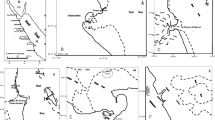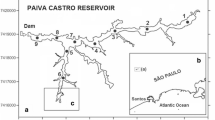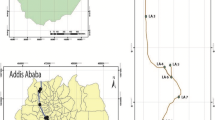Abstract
The seasonal variation and partition of trace metals (Fe, Cu, Zn, Mn, Cd, Cr and Pb) in the surface sediments of the Calabar River are reported. Chemical partition of the metals in the sediments reveals that 2–30% of the total metal load was contributed by the non-detrital (acid-soluble) fraction, while fine-grained host minerals/compounds are the main carriers of the detrital (acid-insoluble) fraction (70–98%). Using multivariate statistical analysis, the seasonal fluctuations in the distribution of some of the metals show significant influence by physio-chemical changes (dissolved oxygen, pH, salinity and conductivity) in the water column. Fe–Mn oxide grain coatings and sulphide materials have been identified as scavengers of some of the non-detrital and detrital trace metals in the sediments. On the basis of index of geoaccumulation (I-geo) and comparison with previous studies, the Calabar River surface sediments have been classified as unpolluted.
Similar content being viewed by others
REFERENCES
Boyle, R. W. 1965. Geology, geochemistry and origin of the lead-zinc deposits of the Keno Hill-Galena Hill area, Yukon Territory. Geological Survey of Canada Bulletin, 111, 302.
Boyle, E. A., Huested, S. S. and Jones, S. P. 1981. On the distribution of copper, nickel and cadmium in the surface waters of the North Atlantic and North Pacific Ocean. Journal of Geophysical Research, 89, 8048–8066.
Bryan, W. G. and Gibbs, P. E. 1983. Heavy metals in pal estuary, Cornwell: a study of long-term contamination by mining waste and its effects on estuarine organisms. Marine Biological Association UK, occasional publication, 2, 112.
Bruland, K. W. 1980. Oceanographic distribution of cadmium, zinc, nickel and copper in North Pacific. Earth and planetory science Letters, 47, 176–179.
Bourg, A. C. M. 1982. Reactions at the water-solid particulate matter (S.P.M.) interface. In: Ahrland, S., Nancollas, G. (eds), Trace Elements in Natural Waters. IUPAC.
Cameron, E. M. 1971. Three geochemical standards of sulphide bearing ultramatic rock: V.M.I, V.M.2, V.M. 4. Geological Survey of Canada Papers, 10, 71–35.
Clifton, R. J. and Hamilton, E. I. 1979. Lead-210 chronology in relation to levels of elements in dated sediments core profiles. Estuary and Coastal Shelf Science 8, 259–269.
De Groot, A. J., Salmons, W. and Allersma, M. A. 1974. Process affecting heavy matals in estuarine sediments. Unpublished Report, Institute of Haren (Gn), Nether lands. In: Loring, D. H. 1976. The distribution and partition of zinc copper and lead in the sediments of the Saguenay fjord. Canadian Journal of Earth Sciences, 13, 960–971.
ENPLAN 1974. Feasibility Report on Cross River Basin. Federal Government of Nigeria Publication, Lagos.
Etim, L., and Akpan, E. R. 1991. Seasonal variation of metals (Hg, Pb As) in the body tissue of Egeria (Lum) (Bivalvia, Tellinacea: Donacidac) from the Cross River, Nigeria. Journal of African Zoology, 105, 465–472.
Etim, L. Akpan, E. R. and Muller, P. 1991. Temporal trends in heavy metal concentrations in the Clam Egeria radiator (Bivalvia: Tellinacea: Donacidac) from the Cross River, Nigeria. Review of Hydrobiology in the Tropics, 24(4), 327–333.
Fleisher, M. 1955. Minor elements in some sulphide minerals. Economic Geology 15th Anniversary Volume, pp. 970–1024.
Grasshoff, P. K., Ehrhardt, M. and Kremling, K. (eds) 1983. Methods of Seawater Analysis, 2nd Ed. Verlag Chemic, Weineiin.
Hirst, D. M. 1962. The geochemistry of modern sediments from the gulf of Paria-II. The location and distribution of trace elements. Geochemica et Cosmochimica Acta, 26, 1147–11870.
Jenne, E. A. 1968. Controls on Mn, Fe, Co, Ni, Cu and Zn concentrations in soils and water, the significant role of hydrous Mn and Fe oxides. American Chemical Society, Advanced Chemical Series, 73, 337–387.
Loring, D. H. 1976a. The distribution and partition of zinc, copper, and lead in the sediments of the Saguenay Fjord. Canadian Journal of Earth Sciences, 13, 960–971.
Loring, D. H. 1976b. The distribution and Partition of cobalt, nickel, chromium and vanadium in the sediments of the Saguenay Fjord. Canadian Journal of Earth Sciences, 13, 1706–1718.
Loring, D. H. 1978. Geochemistry of zinc, copper and lead in the sediments of the estuary and Gulf of St. Lawrence. Canadian Journal of Earth Sciences, 15, 757–772.
Loring, D. H. 1981. Potential bioavailability of metals in eastern Canadian estuarine and coastal sediments. Rupp. P. V. Reun. Cons. Int. Explor. Mer., 181, 93–101.
Loring, D. H. and Nota, D. J. G. 1968. Occurrence and significance of iron, manganese, titanium in glacial marine sediments from the estuary of the St. Lawrence river. Journal of the Fisheries Research Board of Canada, 25, 2327–2347.
Loring, D. H. and Rantala, R. T. T. 1988. An intercalibration exercise for trace metals in marine sediments. Marine Chemistry, 24, 13–28.
Loring, D. H. and Rantala, R. T. T. 1992. Manual for the geochemical analyses of marine sediments and suspended particulate matter. Earth Sciences Review, 32, 235–283.
Loring, D. H., Rantala, R. T. T., Morris, A. W. and Asmund, G. 1985. Non-detrital and detrital particulate metal transport in estuarine systems. In: Caldwell, D. E., Brierley, J. A. and Brierley, C. C. (eds), Planetary Ecology, pp. 187–197. Van Nostrand Reinhold, New York.
Mooke, W. G. and Koene, B. K. S. 1975. Chemistry of dissolved inorganic carbon in estuarine and coastal brackish waters. Estuarine Coastal Marine Science, 3, 325–336.
Moses, B. S. 1979. The Cross River, its ecology and fisheries. In: Proceedings of International Conference on Kainji Lake and River Basin Developments in Africa, p. 365. Kainji Lake Research Institute, New Bursa.
Moses, B. S. 1981. Estimate of fish biomass and potential yield of the Cross River State marine fisheries. In: Proceedings of First Cross River State Fisheries Conference, Calabar pp. 36–41. Fisheries Division, Cross River State, Nigeria.
Nsentip, N. U. 1985. A review of crayfish fishery in Nigeria, with special reference to the Cross River State. In: Proceedings of the 4th Annual Conference of the Fisheries Society of Nigeria., Port Harcourt, November. pp. 42–46.
Ntekim, E. U. 1987. Heavy metal concentrations in sediments from the Calabar River and Qua-Iboe River. MSc Thesis, University of Calabar, Nigeria.
Ntekim, E. E. U. Ekwere, S. J. and Ukpong, E. E. 1993. Heavy metal distribution in sediments from Calabar River, Southeast Nigeria. Environmental Geology, 21, 237–241.
Rohatgi, N. K. and Chen, K. Y. 1976. Fate of metal in wastewater discharge to ocean. Journal of the Environmental Engineering Division ASCE, 102, 675–685.
Salomons, W. and De Groot, A. J. 1978. Pollution history of trace metals in sediments, as affected by the Rhine River. In: Krumbein, W. E. (ed.), Environmental Biochemistry, vol. 1, pp. 149–162. Ann Arbor Science Publications.
Salomons, W. and Förstner, U. 1984. Metals in the Hydrocycle. Springer, Berlin, Heidelberg, New York.
Sundby, B. and Loring, D. H. 1978. Geochemistry of suspended particulate matter in the saguenay Fjord. Canadian Journal of Earth Sciences, 15, 1002–1011.
Sundby, B., Silverberg, N. and Chesselet, R. 1981. Pathways of manganese in an open estuarine system. Geochimica et Cosmochimica Acta, 45, 293–307.
Taylor, S. R. 1966. The application of trace element data to problems in petrology. Physical Chemistry of the Earth, 6, 135–213.
Turekian, K. K. and Wedepohl, K. H. 1961. Distribution of the elements in some major units of the earth's crust. Bulletin of the Geological Society of America, 72, 175–192.
UNESCO 1981. The practical salinity scale 1978 and the international equation of state of seawater: UNESCO Technical Paper Marine Science, 36
UNESCO 1983. Study of the Relationship Between Water Quality and Sediment Transport. A contribution to the international hydrology programme, vol. 26, pp. 58–59. UNESCO, Geneva.
Author information
Authors and Affiliations
Rights and permissions
About this article
Cite this article
Ekpo, B., Ibok, U. Seasonal variation and partition of trace metals (Fe, Zn, Cu, Mn, Cr, Cd and Pb) in surface sediments: relationship with physico-chemical variables of water from the Calabar River, South Eastern Nigeria. Environmental Geochemistry and Health 20, 113–121 (1998). https://doi.org/10.1023/A:1006528324687
Issue Date:
DOI: https://doi.org/10.1023/A:1006528324687




